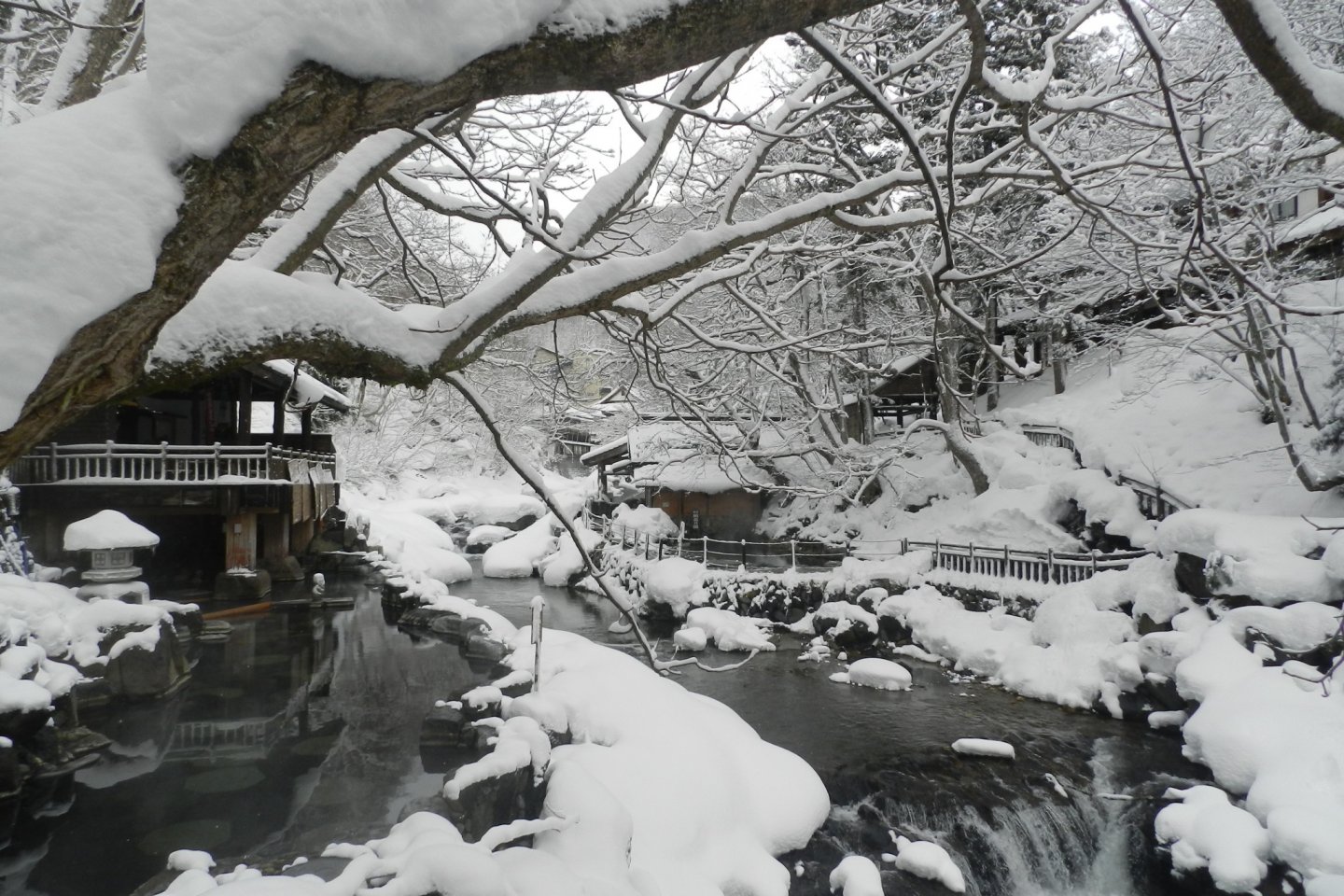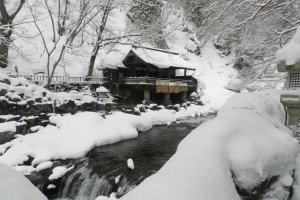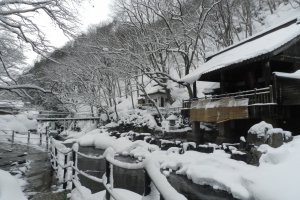If you thought you'd have to travel to the furthest parts of Japan to find hidden hot springs, powder snow or Japanese cultural arts and crafts, think again. Whether you’re after relaxing moments or exhilarating fun (or both), you can find it all a little over an hour from Tokyo.
Resting on the Kanto and Tohoku border lies the town of Minakami Town in northern Gunma. The surrounding mountains and stunning natural environment provide ample opportunities for skiing and snow activities, hot springs, and outdoor pursuits (rafting, canyoning, bungy jumping and mountain biking, to name a few). Its location as a gateway to Northern Japan has also meant that it has a rich cultural and historical legacy that continues into recent times, with its reputation as a hub for the arts and industry.
Below is just a sample of what Minakami has to offer:
Hot Springs
Minakami’s hot spring pedigree is well-known throughout Japan. Word spread initially among local miners, who enjoyed the restorative effects of the waters, and then further to enthusiasts and the general public. Minakami has eight separate hot spring sources and 18 hot spring spas in total for you to enjoy.

Takaragawa Onsen (宝川温泉):
Literally "treasure river" in Japanese, Takaragawa Onsen is regularly cited as one of the best hot springs in Japan. In a nationwide poll taken just last year, 18 hot spring spas in Minakami, including Takaragawa Onsen, was voted as the “most refreshing” hot springs in the country, while also being acclaimed internationally in Lonely Planet and other influential travel guides. Last year they received approximately 30,000 visitors, almost a third of which were foreign visitors. If you need more convincing, as recently as Showa Era Japan, even local bears used to come down from the surrounding mountains to bathe in the waters.
Local folklore has it that people first started coming to this amazing spot around 2,600 years ago. Takaragawa Onsen itself, however, has been officially operating for nearly a century and still retains a number of its original structures.
There are regular hot spring baths located inside, but the real treasure is the four outdoor hot spring baths. These baths are located along the banks of the Tone River, creating a special atmosphere mixing relaxation and nature. Please note that three of the four outdoor hot spring baths are mixed bathing and it is permitted to use bathing wear if you choose. The other outdoor hot spring bath is designated as women only and is screened. To complete the experience, hot spring water is redirected underneath stone pathways to provide natural heating, melting any snowfall and allowing guests to walk between the baths in barefoot comfort.

While the winter snowscape is incredible, it is no less spectacular in the fall when the surrounding foliage boasts beautiful hues of red, yellow and brown. Takaragawa Onsen is open all year round, with the option to stay in their lovely accommodation. It is also possible to simply visit for day-bathing.

Ski and Snow Activities:
The Minakami area receives a large amount of snow all winter long, making for perfect conditions at any of its nine ski resorts. Here, you will find the same quality of powder snow that you would find at some of the well-known resorts just across the Niigata border.
The two resorts below provide different experiences, showing the versatility of ski and snow options available.
Hodaigi Ski Resort:
Hodaigi is about skiing and snowboarding - pure and simple. As soon as you arrive you have a clear view of the slopes and it’s hard not to rush in to get your lift pass immediately. Hodaigi is your stereotypical ski resort with everything designed to get you onto the slopes as easily as possible. Within minutes you can find yourself on that first chairlift you've been eyeing since the car park.

Minakami Kogen 200:
Minakami Kogen 200, on the other hand, provides a very different experience. As an all-inclusive resort, it is more suited to the leisurely traveler. Upon arrival, you're met with a hotel reception, a concierge and comfortable surroundings. At Minakami Kogen 200, you can participate in a wide variety of snow-related activities apart from your usual skiing and snowboarding. Tobogganing, sledding and some other more novel activities - such as snow rafting, snow coach and snow golf - are all available for you to try. There is also a kids' snow wonderland with jumping castles and fun rides designed specifically for the little ones.

Accommodation
Wherever there are hot springs, you can be sure that there are bound to be some fantastic Japanese inns (ryokan) around. Minakami boasts no less than 30 hot spring accommodations at different price points, all providing a memorable stay.
Syoubun (尚文):

A wonderfully small ryokan consisting of only 11 rooms, some with their own private outdoor bath, Syoubun is all about attention to detail. All the meals are exceptionally well-prepared using seasonal local produce, giving you a taste of the best of what Minakami has to offer. There are also indoor and outdoor baths for you to use, which can even be reserved at certain times for your own private relaxation time.
Culture, Arts and Crafts
For centuries, Gunma has been a center of cultural and industrial activity, from the World Heritage-listed Tomioka Silk Mill to modern-day household heavy industry names such as Subaru and Panasonic.
Tsukiyonoyaki (月夜野焼き) - Pottery:

In 1975 during the expansion of Japan’s shinkansen network, construction in the Minakami region exposed rich deposits of clay in the area. The clay was designated as official pottery clay because of its high quality. Since that time, the family has been crafting and making pottery. The store / workshop is now in its third generation with the traditions having been passed down within the family. If you visit, it is possible for you to try creating something special yourself, using either the pottery wheel or hand-moulded clay, with instruction and guidance provided by master potters. Please note that anything you make will need to be twice-fired and will not be ready for between 1.5 to 2 months. They are happy to deliver to a location within Japan but international deliveries are a little more complicated.
Everything is made by hand on-site and encompasses the full range of artistic pieces and general commercial ceramics. Pottery enthusiasts enjoy visiting the museum located on the premises, which contains a tribute to the founder and special unique pieces.
Tsukiyono Biidoro Park (月夜野びーどろパーク) - Glass Blowing:
Dating back to 1908, Joetsu Crystal Glass Co has the proud ability to call itself the first glass blowing company in Japan. Originally, Joetsu was located in Tokyo (and was one of the first companies to have its own baseball team), but it moved to Gunma in 1947. The company is now in its third generation and is still family-run. With great pride, the current director was quick to point out that all of the employees on the glass blowing floor are born and bred Minakami locals. Joetsu now sells products all over the world, perhaps most famously under the Mikasa brand.
In addition to its longevity, the company has a very distinguished history. The Emperor has made visits to the factory twice and you can see his creations in the museum. They also have the honor of having six of their master craftsmen designated as National Treasures of Japan.
The factory operates commercially and produces hundreds of pieces per day. Yet it has been specially designed with walkways that allow you to see the craftsmen in action, with signboards providing helpful information on the processes taking place before you. If you like you can even make something of your own with the finished product being delivered to you (within Japan) in two days' time.

In addition to the factory, the premises also include a display store with glassware from all over the world, a workshop space that can host up to 200 people, and a museum gallery that holds rare glass pieces from around the world and works commissioned by famous artists.
Nezu Kirizai (根津桐材) - Paulownia Furniture Shop:

Paulownia, or kiri, is famed in Japan for its great qualities in furniture manufacturing. It is lightweight, impervious to moisture, doesn’t warp or split with age and - with the right treatment - is fire-resistant. It was often used in the Edo and Meiji eras to store valuable items. Nezu-san is a third-generation master craftsman, with his two sons apprenticing underneath him. With the demand for large chests and wardrobes dwindling, Nezu-san is looking to use this wood in innovative ways for the modern world, such as wooden smartphone speakers, card holders and even stylish wooden briefcases. Visit the roadside shop and Nezu-san will be happy to take you around his workshop and show you where the magic happens
As an indication of his dedication to his craft, Nezu-san's family actually owns a mountain in neighbouring Niigata prefecture where they have planted the kiri trees that are then used in their work, completing the entire cycle from start to finish.
Takumi no Sato (たくみの里) - Craftsmen’s Village:
Takumi no Sato is a recreated craftsmen’s village, with 23 different workshops showcasing a wide range of different traditional techniques. Some of the workshops include origami, traditional Japanese doll and mask painting, silverworks, silks, fragrances and soba making. Rental bicycles are available so you can pop in and out of the different shops throughout the day, seeing demonstrations and trying your hand at some of the traditional arts.
Dole Land:
Dole Land part of the Dole Food Company, the largest producer of fruits and vegetables in the world, and provides a seasonal activity that everyone can enjoy. All you can eat fruit picking is a major seasonal draw. In addition to fruit picking, there is a cooking studio and fruit café providing ideas on how to use your freshly-harvested yield.

So, before planning a trip elsewhere, why not consider Minakami in Gunma?



































